
Deconstruction with a Gun – Childish Gambino’s “This is America”
What are we to do anymore? Is there any place left to go? What is there of rebellion? Dissent? Does art, the last bastion of petulance, even matter anymore? I was recently discussing with a friend of mine this very issue (the same individual whom I referred to in my article about John Parish’s new single concerning the suicide of Mark Linkous). He is far more knowledgeable than I am on music, but even he had admitted, despite being more inclined to the avant-garde and not being a huge disciple of either genres, that EDM and rap have become the most progressive forces in music today – both in terms of innovation and lyricism. Of all the genres that were having their heyday in the early- to mid-2000s, very little has come of them lately. At the same time there hasn’t really been anything new, either. Our favorites have been recuperated into the very stream of which they objected and then reinforced what once we rejected. I know, wah, wah, same old song, cry me a river, etc.

But wait. Childish Gambino’s “This is America” lays waste to the American landscape, not just for African-Americans but in a statement that reaches into our collective prejudice. What can be more transgressive than combatting the recent regress into modernist ideals such that grand images of what it means to be human have come back into the fore? This has resulted in a dissonance which many have not been able to reconcile with life-as-it-is-lived and has resulted in the loss of innocent lives, often at the behest of racial, sexual, and religious ‘purity.’ I am not trying to downplay the facet of African-American culture portrayed in Childish Gambino’s newest song, something which is both imperative and that I am far from equipped to comment upon, but it does offer a window through which the verve of discontent is able to branch out and highlight the parallels of intolerance in whichever form it may manifest. The beauty of the particular is in its ability to raise itself up to the universal.

There is a fundamental aporia holding up the American system in its division of the two-party system wherein each, rather than acting against each other, have synergistically fed upon the detritus of each and fueled their gambit into stalemating resistance of any kind while having reaped the benefits of our mutual disillusionment. And this has most poignantly resulted, both recently and in our all-encompassing past, in the destruction of minority communities. Childish Gambino’s “This is America” in this sense verges on Howard Zinn’s A People’s History of the United States, though in a more popular and adulterated form. That is not a criticism, however. For in our attempts to break down the artifice sometimes what is needed is first to embrace the image so as to infiltrate the belly of the beast in a Trojan trap beat. [Childish Gambino is the stage name of Donald Glover.]
0:00-0:35 [Intro]
In the opening we get a folk refrain mixing acoustic with choral accompaniments lending to a sense of ’90s soul with modern beats. Glover appears shirtless and seemingly optimistic with an almost vaudeville smile on his face. The background to the video is white and clean, which lends a sense of universality. Were this the squall line it would be the same ol’ same ol’ “sounds good,” let’s dance regurgitation. In other words, it starts off mundane. Moreover, we get the typical post-modern tension in the choral line of “yeah yeah yeah yeah yeah/ yeah yeah yeah go go away” wherein one is both beseeched to approach and told to step off because, as we all now know, no one is good enough – not even ourselves. It is the mating dance we are all so familiar and bored with. It’s comfortable, allows us to flirt without danger, all the while meaning nothing: the whole “full of sound and fury signifying nothing” (Macbeth; Scene 5, Act 5).

0:36-0:49 [Bridge]
Then we get a trap rhythm with Gambino moving along to the bridge. Familiar themes of partying and money. The old score of making it in America. This is the American dream. Move like this, you spell success. Move well and maintain pitch? You got a fucking record! To hell with it, this is the quintessential story wherein the individual delights and simultaneously profits off of just being themselves. This is what music — and the American recuperative system — have been feeding us for at least the past 30 years (ever since hip-hop went mainstream and rounded off the edges of groups like Public Enemy, feeding off the angst so as to suppress class struggle for the sake of marketable dissent). Whether it be optimistic or mournful, there has always persisted a sense of overcoming one’s situation, that even our lows are fodder for making something of ourselves… We shall overcome! and all that bullshit… It’s the typical frontline posturing that has made such a success of seemingly humdrum artists who otherwise would never have been noticed if not for a good publicist. And the same would be for this song, but…
0:50-1:10 [Chorus 1]
…then it happens. A black man with a white shroud over his face is shot in the back of the head: “This is America.” The person shot is alluded to be the individual playing acoustic in the opening. The allusion can’t be helped but be made between Abu Ghraib and black culture. It is about being subordinate. There is so much tension within Arabic animosity towards America that it is little wonder that Glover creates a parallel here between the victimization of ‘brown’ dissidents and black America. One may not be comfortable with the conclusion, but is there really such distance between the seemingly endless list of black men’s names extra-judicially killed by police and the shrouded figures indicted without jury rotting in Cuba for the sake of freedom? Not to mention that Glover is the one firing the shot. It hints towards the black community turning their back on their roots, which is echoed in the shrouded/anonymous guitar player carrying over Glover’s beats while at the same time being assassinated as it transitions into the harder, more familiar (and, by extension, white-washed) chorus.
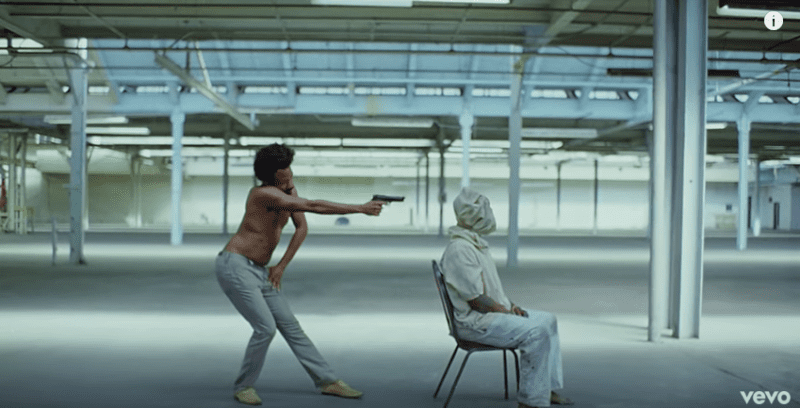
1:10-1:39 [Verse 1]
“…Don’t catch you slippin’ up/…look what I’m whippin’ up.” Gambino keeps the same choreography though slightly akimbo and maintains the smile of a person who, despite having killed their idols, must persist. Just as we do. It echoes the pathos of letting go of one’s chains in order to move forward. But the distorted bass maintains the chords of the killed folklorist, and the blood of the dead remains. Going into the verse, Glover is accompanied by dancers dressed as students. He periodically looks back as they revel in what he has left them. Despite the fact that it was built on the backs of martyrs murdered by his own hand, he persists in moving forward, and they get lost in the noise. The verse states “Look at how I’m livin’ now… police be trippin’ now… guns in my area… I gotta carry ’em.” The violence endemic of the culture is now detached from its historical roots. Without the idols of yore, the violence committed against them makes no sense, and so it is returned without critique. Gambino alludes to a guerrilla war as a specter of what is necessary, but it is a faction without a history. Terror for terror.
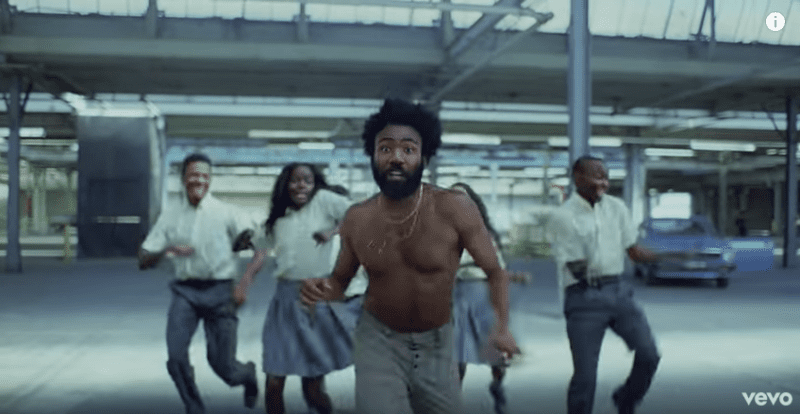
1:40-1:55 [Chorus 2]
A chorus from a church choir repeats the refrain in an exuberant exaltation embodying everything that white culture expects from the black community. Soul. Religion. Hope. Passivity. And, ultimately, enchainment to a secure image of white-washed resistance wherein their fight for emancipation is tarnish-free of any obstruction of actual integration. Gambino enters through a side door as a spectator dancing to the rhythm of a moribund present.
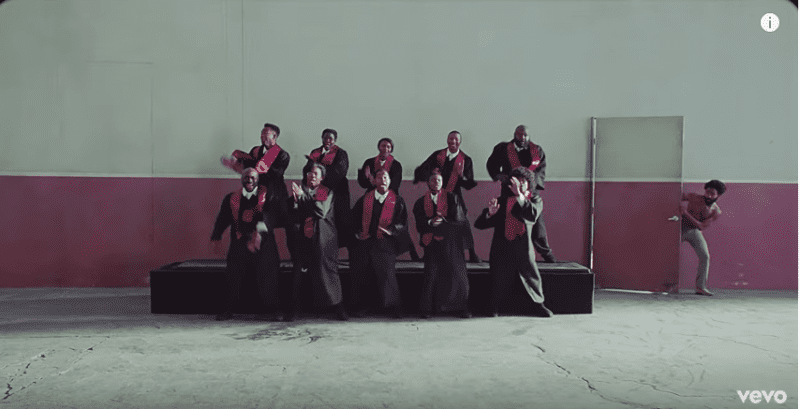
1:56-2:44 [Verse 2]
Glover shoots them all with an assault rifle. This is a clear reference to Dylann Roof, who infiltrated a black church and murdered nine people in Charleston. He goes back into the isolated dancing and drum and bass beats that characterized the previous assassination of the acoustic singer. Both show the roots of black music. One had the blues singularity whereas the other maintained the sense of community in the gospel church. All have been killed – both at the hands of an individual with a gun. This is America. This is America where the image is to be attacked. The person in question who could be held accountable for the deterioration of the whole is left to speak on behalf of those who died in their name. Indistinguishable figures are seen running with make-shift weapons across an immobile and impotent police force. We are all overwhelmed. The attack is personal yet indistinct. We no longer can tell the difference between the ideal and thing-in-itself. We are left with the spectacle of rebellion adrift without roots. The student dancers join back in as Glover simultaneously juxtaposes selfies with the image of Oaxaca – a region of Mexico that is geographically situated near and has been aided by Chiapas, which is known for the 1994 Zapatista uprising. This lends hope to the verse as if we were to find our way through the labyrinth of recuperation.
2:45-3:31 [Refrain]
But in the final refrain Glover makes of his arms a(nother) gun, and the dancers scatter with a scream. The sense is that the violence has turned into a fratricidal image, too egoistic to turn it on himself. As he puts down his hands he seemingly picks up a joint. Alone, the choral intro joins the refrain as Glover revisits the image of the murdered guitarist (still shrouded). The whole thing is recuperation. We have grown weary and gone back to the origins. The trap beats, choir singing, and chords of the folklorist combine as the refrain is continued to the effect of “make that money, black man.” But this time around it can’t be anything but a satirical coda. The apogee is in realizing the shallowness of today’s claim being the same as its historical birth. The rebellions ended up emulating the very system they were intended to defy, and so in the end everything that had been achieved comes to naught, for the protests of the past had simply been fodder for further subjugating future generations, which becomes an indictment of the present.
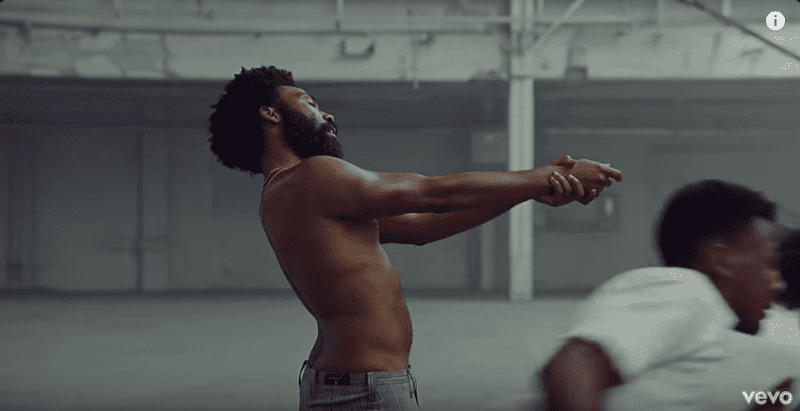
3:32-4:04 [Outro]
In the final portion Glover is running down the same white clean corridors, only this time chased by the first white yet obfuscated faces. You get a sense that he is being harangued for what he has done with this song. He has exposed the image to be a corpse; the whole song was a farce – yet a farce that succeeded in dissecting the veil of violence that has plagued all resistance and been used in its name to keep any and all rebellion down. Young Thug sings the outro:
“You just a black man in this world
You just a barcode, ayy
You just a black man in this world
Drivin’ expensive foreigns, ayy
You just a big dawg, yeah
I kenneled him in the backyard
No probably ain’t life to a dog
For a big dog.”
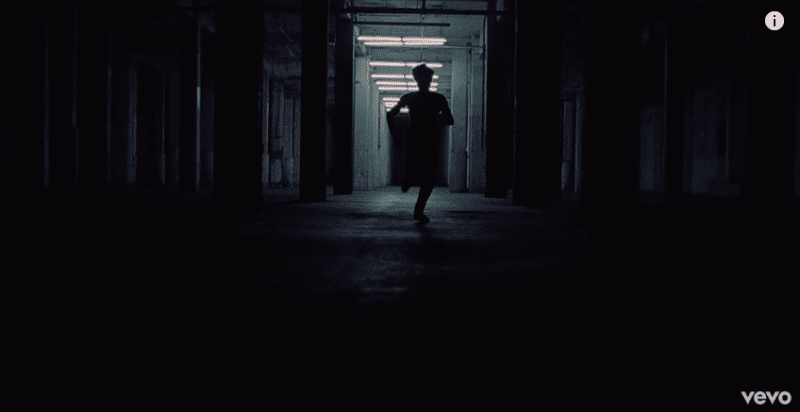
The successful ‘black man’ is merely the puppet of the elite, driving expensive foreign cars yet still tagged and numbered, kenneled in the backyard, chained to the system of recuperation. Yet what Glover is doing here is embracing the spectacle while subverting it. He is in part contributing to the system of recuperation while at the same time using it to expose hypocrisy. As Public Enemy says in the song “Fight the Power:” “Make everybody see, in order to fight the powers that be.” If the only way to have a voice is to be subsumed within the system, then the only real source of rebellion left is self-immolation.
